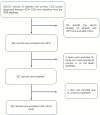Epidemiology and survival of patients with central nervous system solitary fibrous tumors: A population-based analysis
- PMID: 36755855
- PMCID: PMC9899901
- DOI: 10.3389/fonc.2022.977629
Epidemiology and survival of patients with central nervous system solitary fibrous tumors: A population-based analysis
Abstract
Background: The objective of this study was to determine population-based estimates of the epidemiology and prognosis of central nervous system solitary fibrous tumors (cSFTs).
Methods: We extracted the data of patients diagnosed with cSFTs between 2004 and 2018 from the Surveillance, Epidemiology, and End Results database. We analyzed the distribution of patients according to their demographic and clinical characteristics. Binary logistic regression analysis was performed to predict which patients would be diagnosed with malignant cSFT. Possible prognostic indicators were analyzed by multivariable Cox proportional hazards models.
Results: A total of 650 cases were included. The majority of patients were diagnosed at 50-59 years old, and the median age at diagnosis was 55 years. A total of 13.4% of the tumors were located in the spinal canal, and 24% of the tumors were benign. Most of the tumors were larger than 3 cm, but distant metastasis was rare. Tumor resection was the first choice of treatment for these patients, and total resection was achieved in 51.1%. Radiation therapy after surgery was also administered to 42.3% of the patients. The median survival was 57 months. Intracranial tumors and tumors with distant metastasis tended to be malignant. The results of the log-rank test showed that the patients who underwent total resection had better overall survival (OS), but the effect of radiation therapy after surgery was not significant.
Conclusion: cSFT is a rare and aggressive type of tumor. Tumor resection is the first choice for treatment, and radiation therapy after surgery does not improve OS. Patients older than 60 years of age who are diagnosed with intracranial tumors, malignant tumors and distant metastasis have worse OS outcomes than their counterparts.
Keywords: CNS disease; SEER program; hemangiopericytoma; primary brain tumor; solitary fibrous tumors.
Copyright © 2023 Lu, Xu, Dong, Jin and Wang.
Conflict of interest statement
The authors declare that the research was conducted in the absence of any commercial or financial relationships that could be construed as a potential conflict of interest.
Figures



References
-
- Louis DN, Ohgaki H, Wiestler OD, Cavenee WK, I.A.f.R.o. Cancer . WHO classification of tumours of the central nervous system. Int Agency Res Cancer (2016) 249–54.
LinkOut - more resources
Full Text Sources

